Nov 03, 2022
Shaping the future, atom by atom
Dagmar Möbius
Quantum physics is complex and abstract. What do a topological coffee table, a cookie jar analogy, hairy donuts and a half-dead cat have to do with it? They all give insight into the fundamental research on quantum technologies conducted by the ct.qmat Clusters of Excellence.
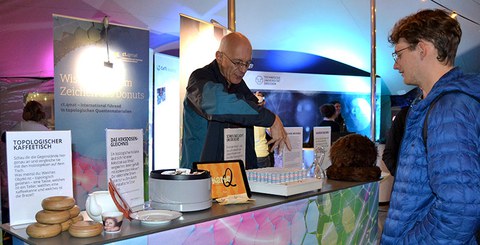
ct.qmat Spokesperson Prof. Matthias Vojta explains how we can “send light around the corner.”
ct.qmat stands for Complexity and Topology in Quantum Matter. Spokesperson for the Cluster of Excellence Professor Matthias Vojta can understand that those outside the field could have difficulty understanding these phenomena. “We conduct fundamental research in physics,” he says. “This is very abstract, so we have to provide a decent amount of background information.” They focus on material research for the future. “We’re talking about technical advancements across a timespan of about ten years. This could concern energy-saving electronics, sensor technology and medical technology. We don’t have a specific application in mind. Rather, we are driven by curiosity.”
About 400 physicists, chemists and material researchers from Technische Universität Dresden and Julius-Maximilians-Universität of Würzburg work together at ct.qmat. It is the only cluster in Germany that works across state borders, collaborating with affiliates from the Bavarian Center for Applied Energy Research (ZAE Bayern), Helmholtz-Zentrum Dresden-Rossendorf (HZDR), the Leibniz Institute for Solid State and Materials Research (IFW), the Max Planck Institute for the Physics of Complex Systems (MPI-PKS) and the Max Planck Institute for Chemical Physics of Solids (MPI-CPfS).
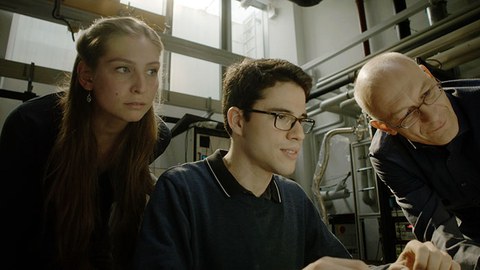
Prof. Matthias Vojta (r.) with PhD students Teresa Tschirner and Pedro Monteiro Consoli.
Surprisingly simple images
“Topology is a sub-discipline of mathematics. Over the past 15 years, it has been responsible for revolutionary applications in physics, for which multiple Nobel prizes have been awarded,” Prof. Vojta explains. “But let’s begin with simple images.” Atop the topological coffee table sit objects with properties that remain intact even when deformed. “A cup with a handle and a ring both have a hole. That is a topological property. However, the inside of the cup is not a hole.” Quantum physicists observe material properties. “Physics has conventionally measured local properties. So, it is important to differentiate between local and global properties,” explains the Cluster Spokesperson. “This demonstrates the radical change that thought in physics has undergone.”
Hairy donuts, magnetic vortices and the cookie jar analogy
“You can’t comb a sphere free of vortices,” Prof. Vojta demonstrates while brushing a hairy plush ball. “But you can comb a donut without creating vortices.” What we learn is that topology also has to do with vortices. In physics, different vortices have a role to play. Magnetic vortices, for instance, are key for storing information. If we manage to create vortices from minuscule atoms, these will be extremely stable and “could potentially be ready for data storage in about ten years.”
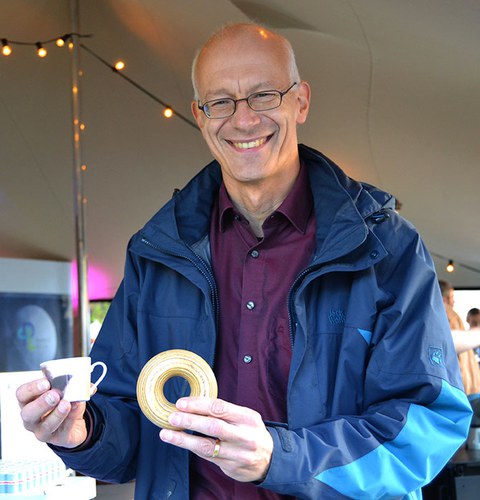
Donut science – visual comparisons provide non-experts insight into the abstract world of quantum matter research.
A topological insulator can be compared to a metal cookie jar filled with insulating cookies (or gummy bears, if you prefer). An electric current can only flow on the outside of the metal container. A researcher from Würzburg found proof of this effect 15 years ago. In the future, this could mean less electricity consumption in chips, in keeping with the ultimate goal of low-loss electronics. “This also works with light,” says Prof. Vojta. Directing light around a corner is no gimmick, but rather could boost data processing in the next 20 or 30 years. Constructing small, high-performance lasers is not an easy task. But about one-and-a-half years ago, there was a breakthrough in the lab. Prof. Vojta thinks an application for many different areas will be feasible in about five years’ time.
The quantum kitty that’s got kids 11 and up excited
Experts from the ct.qmat Cluster of Excellence spent over a year developing “Kitty Q,” a game for children ages 11 and up designed to be more fun than educational software. “In this adventure, we have integrated 20 scientific facts about the quantum world in a child-friendly and understandable way. You don’t have to understand anything about physics,” says Prof. Vojta. The aim of the game was to demonstrate that physics is fun without confronting kids with insanely difficult concepts, free of cost. And funding from the Federal Ministry of Education and Research as part of its “Research in Germany” initiative made this possible. Matthias Vojta and his colleagues are pleased that “Kitty Q – A Quantum Adventure” has already been awarded multiple prizes, including the “Goldener Spatz” in the Digital category at the German Children’s Media Festival of the same name.
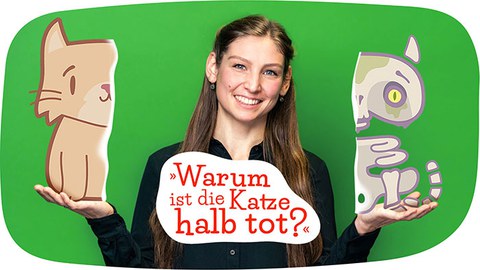
“Why is the cat half-dead?” Children ages 11 and up can find out in the multiple award-winning free mobile game “Kitty Q – A Quantum Adventure.”
The next great success cannot be foreseen
It is simply impossible to foresee the next great success in quantum matter that will reveal its mysterious phenomena under extreme conditions such as ultra-low temperatures, extremely high pressure or super strong magnetic fields. This is what makes the field so exciting for researchers. ct.qmat is always on the lookout for bright minds. Each year, the Quantum Matter Academy brings together PhD students, postdocs and even Master’s students from all research institutes for three days. “They present the results of their work and elucidate how research and personal life can be reconciled,” says Coordinator Dr. Kerstin Brankatschk. “They also learn how to communicate with one another, and some find out how to organize a conference.” Early-career researchers have the opportunity to acquire information about rights and obligations, language courses and the Graduate Academy.
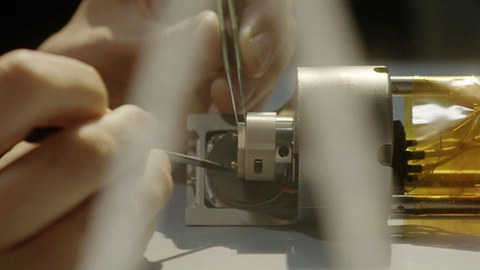
Future research
Contact:
TU Dresden
Institute of Theoretical Physics
ct.qmat – Complexity and Topology in Quantum Matter Cluster of Excellence
Prof. Matthias Vojta
Tel.: +49 351 463-34135
Email
